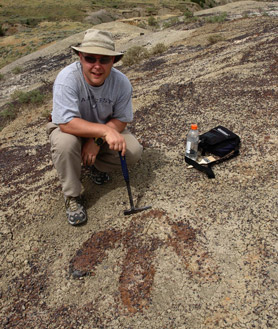Amazing Jurassic Highway Discovered In Canada
Trackway that shows Footprints of Three Types of Dinosaur Discovered
The town of Sparwood lies in the Elk Valley, one of the most rugged and beautiful areas of British Columbia. It is famous for wildlife and its natural beauty, now some ancient residents of this particular area of Canada are grabbing the headlines.
Dinosaur Footprints
Local coal miners exposed a near vertical slab of rock that contains the trackways of at least three different types of dinosaur. News of this find reached local palaeontologist, Rich McCrea, the curator of the Peace Region Palaeontology Centre at nearby Tumbler Ridge, who was despatched to investigate. The strata in which the footprints were found have been dated to approximately 135 million years ago (Hauterivian faunal stage). Fossils of dinosaurs in Lower Cretaceous strata in North America are relatively rare, compared to Upper Cretaceous finds.
The footprints are of a big theropod (meat-eating dinosaur), most likely to be a member of the Allosauridae. Some of these large three-toed prints are a metre long, indicating an animal the size of an Allosaurus fragilis, perhaps 12 metres long or more. The second set of prints are the typical more rounded prints of a large sauropod (long-necked dinosaur). These prints are quite size-able and indicate and animal that could have weighed as much as 40 tonnes. The third set of smaller dinosaur prints have yet to be identified.
Jurassic Highway
Commenting on the importance of this discovery, McCrea said: “we’ve been waiting for this kind of find,” . “It was a long time coming.”
Footprints and trackways are known as trace fossils. They preserve evidence of the activity of animals. They have a major advantage over other types of fossils such as bones and teeth (body fossils). Unlike body fossils, in which the body may be transported a long way after death, far away from the area where the animal or plant actually lived, most trace fossils are direct, in situ evidence of the environment, time and place where the animal lived.
A Large Theropod Footprint (Hell Creek Formation USA)
Picture credit: Dr Phil Manning (Manchester University)
The picture above shows the discovery of a single theropod footprint in Upper Cretaceous sediment. The dinosaur that made the print has yet to be formerly identified but this could be the footprint of a Tyrannosaurus.
To read more about the finding of a possible tyrannosaur footprint: Possible T. rex Footprint Found.
Trackways of a large theropod in situ with a sauropod such as these uncovered in B.C. have never before been found in Canada, although McCrea has found sauropod tracks in the same region in 2000. Evidence of big carnivore such as an Allosaurus has been found in the province as well as in neighbouring Alberta, but this trackway discovery is still very significant for palaeontologists.
Trackways can tell researchers much more about a dinosaur than the finding of a single, isolated bone. “When you compare it to finding a single bone … finding a trackway is like finding a whole skeleton,” McCrea added.
“You get far more information from it. You can learn about herding behaviour, predator-prey interactions. We get to do a little more on the biological end of things like bio-mechanics … how they walked around.”
McCrea and his assistant plan to spend a fortnight at the site, and will make a latex mould of the footprints to take back to Tumbler Ridge. They will also take three-dimensional photos of the footprints and map the trackways, but they will not actually be removing them, as to remove them may damage these valuable items, evidence that dinosaurs walked around British Columbia 135 million years ago.
For dinosaur models and figures including tyrannosaurs: PNSO Age of Dinosaurs Figures and Models.


